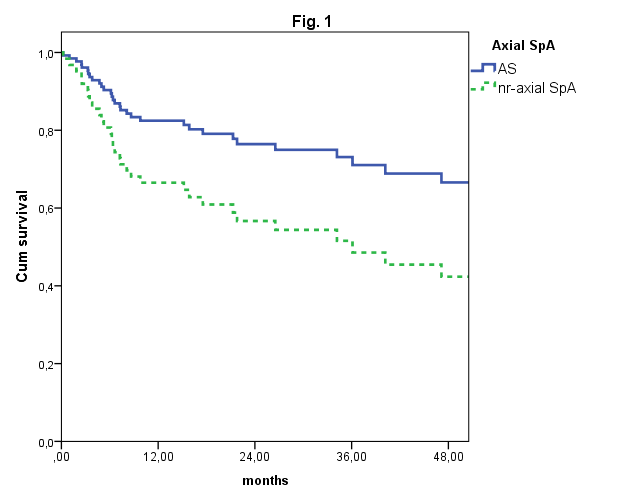Session Information
Date: Monday, November 6, 2017
Title: Spondyloarthropathies and Psoriatic Arthritis – Clinical Aspects and Treatment Poster II
Session Type: ACR Poster Session B
Session Time: 9:00AM-11:00AM
Background/Purpose: The efficacy of Golimumab (GLM) treatment in spondyloarthritis (SpA) has been widely documented. The aim of this study was to analize the long-term retention of GLM and to identify independent predictors of retention in patients with SpA.
Methods: Prospective monocentric cohort of Spa patients treated with GLM according with clinical practice. Study was approved by local Ethics Committee. Demographic and clinical variables were analyzed with Cox proportional hazard regression model.
Results: 105 patients were included, 49 (46.7%) Ankylosing Spondylitis (AS), 40 (38.1%) non-radiographic axial SpA (nr-AxSpA) and 16 (15,2%) peripheral SpA. The baseline characteristics of the patients are shown in Table 1. Mean follow-up time 23.8 months (SD 20.9). Mean survival time was 47.2 months (95% CI: 39.4-54.9). Age, gender, HLA-B27, radiographic or nr-AxSpA and previous biological use were significant in the univariate analysis. Concomitant DMARD had no influence on GLM retention rate (HR: 1.2; 95% CI: 0.6-2.4; p: 0.6).
Table 1. Baseline demographic and clinical characteristics of the patients.
|
|
All (axial and peripheral SpA) |
AS |
nr-AxSpA |
|
Age -mean (SD)-years |
45.1 (13.2) |
51.1 (10.8) |
39.8% |
|
Male gender % |
49.5% |
61.2% |
47.5% |
|
Mean evolution time (SD) years |
11.8 (12.3) |
18.8 (10.1) |
7.3 (10.3) |
|
HLA-B27 |
69.6% |
90.7% |
52.6% |
|
Uveitis |
16.2% |
24.5% |
10.0% |
|
Back pain -mean (SD) |
7.5 (7.0) |
6.5 (2.4) |
9.1 (10.7) |
|
BASDAI -mean (SD) |
6.2 (1.6) |
6.3 (2.1) |
6.2 (1.2) |
|
BASFI -mean (SD) |
5.8 (2.3) |
6.0 (2.4) |
5.4 (2.1) |
|
CRP mg/dl Mean (SD) |
1.1 (1.7) |
1.5 (2.1) |
0.65 (1.4) |
|
Concomitant DMARD % |
29.8% |
31.3% |
7.5% |
|
Biological Therapy naïve % |
45.7% |
30.6% |
60% |
Upon Cox regression analysis, patients with AS had significant better retention rate compared to nr-AxSpA (HR: 2.1; 95% CI: 1.1-4,2; p<0,035). There was a numerically better GLM retention rate in patients treated previously with less number of biologicals, but did not reach statistical significance. 39/105 (37%) withdraw GLM treatment. 26/39 (66,7%) due to lack of efficacy, 6/39 (15,4%) due to adverse events and 7/39 (17,5%) due to other reasons.
Conclusion: Real-world Golimumab retention rate in patients with Spondyloarthritis was good and did not depend on concomitant treatment with DMARD. Patients with Ankylosing Spondylitis had a better Golimumab retention rate than patients with non-radiological Axial Spondyloarthritis. A better retention rate was expected in patients who had previously used less biological, but was not found due probably to the low effectiveness of Golimumab in patients with non-radiological Axial Spondyloarthritis.
To cite this abstract in AMA style:
Serrano B, Gonzalez CM, González R, Martínez-Barrio J, Ovalles-Bonilla JG, Nieto JC, Janta I, Valor L, López Longo FJ, Monteagudo I. Golimumab Retention Rate in Patients with Spondyloarthitis. Differences between Ankylosing Spondylitis and Non-Radiographic Axial Spondyloarthritis [abstract]. Arthritis Rheumatol. 2017; 69 (suppl 10). https://acrabstracts.org/abstract/golimumab-retention-rate-in-patients-with-spondyloarthitis-differences-between-ankylosing-spondylitis-and-non-radiographic-axial-spondyloarthritis/. Accessed .« Back to 2017 ACR/ARHP Annual Meeting
ACR Meeting Abstracts - https://acrabstracts.org/abstract/golimumab-retention-rate-in-patients-with-spondyloarthitis-differences-between-ankylosing-spondylitis-and-non-radiographic-axial-spondyloarthritis/

